China Is Bouncing Back, but Can We Trust Its Numbers?
China's economy looks to be well on its way to recovering from the coronavirus-imposed lockdown.
"A rebound in sales of autos, apartments and smart phones suggests that China’s domestic demand story survived the coronavirus lockdown."
China's economy looks to be well on its way to recovering from the coronavirus-imposed lockdown. A return to normal may not happen until next year, but consumer spending, manufacturing and investment appear to be all bouncing back strongly. This raises the perennial question, “Can we trust China's macro numbers?” A look at sales data from multi-nationals (MNCs) doing business there suggests that China's retail sales growth rates are realistic.
All of us at Matthews Asia send our sympathies to everyone effected by COVID-19, either directly or indirectly, and we extend our gratitude to all health care professionals, scientists and service providers who are diligently working to help and provide care to those in need around the world.

Progress towards controlling COVID-19 is key
When thinking about prospects for the Chinese economy, one of the most important factors is whether the coronavirus remains under control. At this point, China appears to have wrestled COVID-19 into submission. On May 14, only 91 coronavirus patients were in hospital, down from the February 17 peak of 58,016. The recovery rate is now 94% across China, up from 12% three months ago.
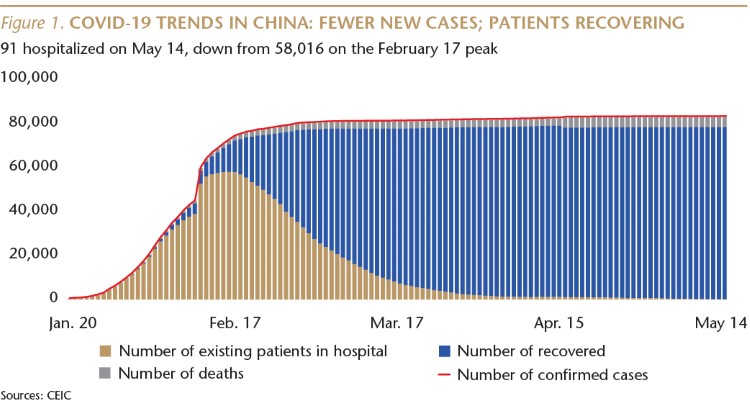
China began gradually lifting social distancing and other restrictions for areas outside of Hubei Province (where Wuhan is the capital city, and where the virus was first identified) on February 9. During the 14 days prior to that date, the average daily number of new COVID-19 cases was 657, and the average daily number of deaths was two, both for China ex-Hubei. In contrast, during the 14 days ending May 17, there was an average of five new daily cases and a total of one death due to COVID-19 in China ex-Hubei.
The social distancing restrictions began to be lifted in Wuhan on April 8. During the 14 days prior to that date, there were a total of only two new COVID-19 cases, and the average daily number of deaths was three. During the 14 days ending May 17, there were a total of six new cases and zero deaths due to COVID-19 in Wuhan.
(During the 14 days ending May 17, there was an average of 24,253 new daily cases and 1,599 daily deaths in the U.S., and an average of 4,078 new daily cases and 442 daily deaths in the U.K.)
It is also encouraging that two weeks after a five-day national holiday in China, when over 100 million people traveled for leisure, there has not been a spike in COVID-19 cases.
As in other countries, the potential for a rebound in coronavirus cases is the biggest risk to a post-lockdown economic recovery, but, at the moment, a combination of testing, contact tracing and social distancing seems to be keeping the virus at bay.
And, it is worth noting that the rate of COVID-19 deaths per 100,000 population in China (0.3) is similar to that of some other countries in the region: Singapore (0.4), South Korea (0.5), and Japan (0.6).
A nascent V-shaped recovery
As we wrote in the April 17 Sinology, China's first quarter economic data was dismal. Real (inflation-adjusted) retail sales, for example, declined 21.8% year-on-year (YoY), industrial value-added fell 8.4% YoY, and fixed asset investment was down 16.1% YoY.
We also wrote that those dismal numbers were the result of a virus that shuttered most shops, factories, offices and restaurants, and did not reflect structurally weak supply or demand, or a financial system crisis.
Now that the virus has been brought under control in China, those businesses have gradually been opening, and life is starting to return to normal, as are many key economic indicators.
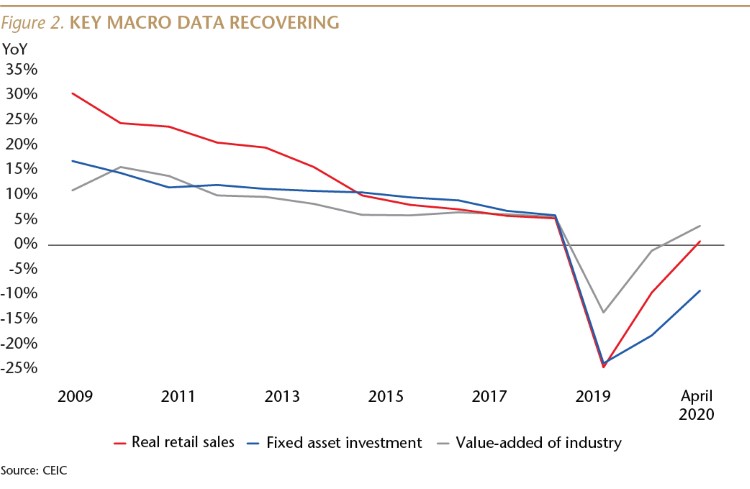
China is a domestic-demand driven economy, so the recovery in consumer spending is critical. Last year was the eighth consecutive year in which the consumer and services (tertiary) part of GDP was the largest, and consumption accounted for almost 60% of GDP growth.
Real retail sales growth plummeted to -23.7% YoY in January/February, but bounced to be only down 9.1% in April.
Auto sales were down 79.1% YoY in February, but were up 4.4% in April. This was, in fact, the first month of YoY auto sales growth since June 2018.
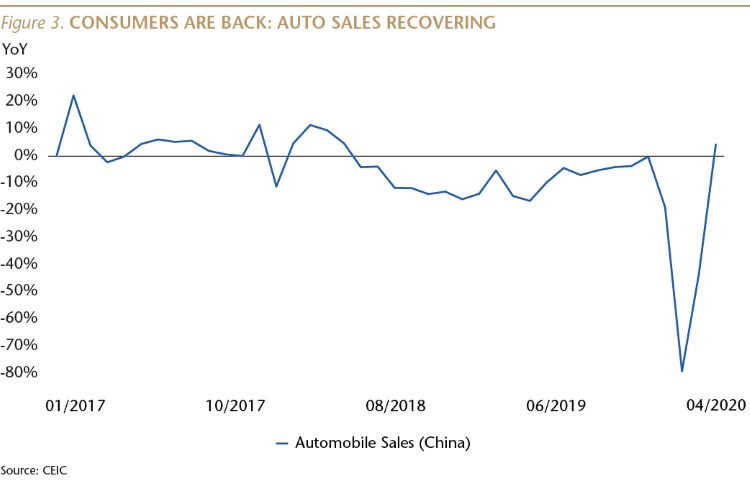
Residential property sales also recovered strongly. After being down 39.2% YoY (in square meter terms) in January/February, sales were only down 1.5% in April, compared to an increase of 2.7% a year ago.
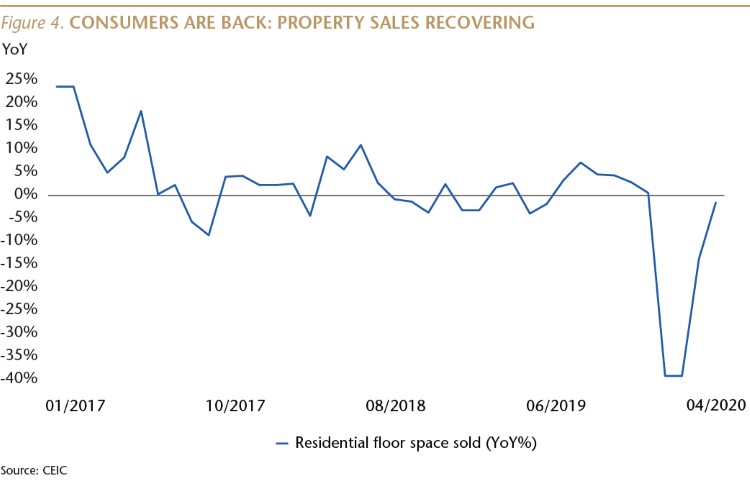
The recovery of sales of autos and homes reflect that middle-class and wealthy consumers have both sufficient money and enough confidence in the future to spend it. And it wasn't only big-ticket items that bounced back last month. Smart phone shipments were down 54.7% YoY in February, but rose 17.2% in April, beating last April's 6.5% growth rate.
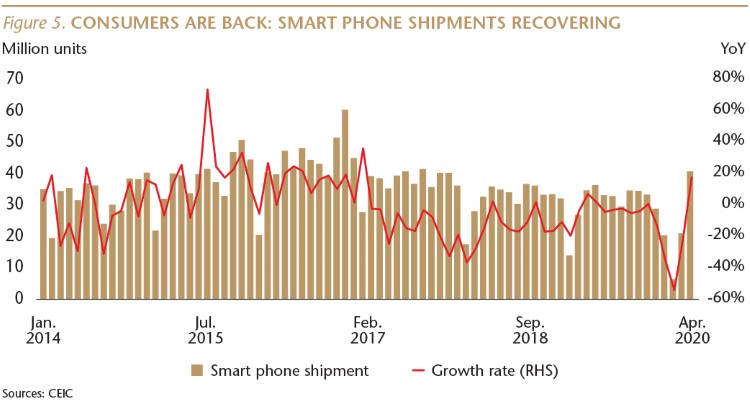
This significant recovery in consumer spending raises the perennial question, “Can we trust China's macro data?” Numbers reported by publicly traded MNCs suggest that China's retail sales data is reasonable.
Figure 6 provides China sales growth rates for a wide range of MNCs for 2019, ranging from double-digit YoY growth for L'Oréal, Nike, Adidas and BMW, to double-digit declines for Apple and GM. But, in our view, the long list of companies reporting strong revenue growth is consistent with China's official nominal retail sales growth rate of 8%. (The auto companies reported units sold, rather than revenue for China.)
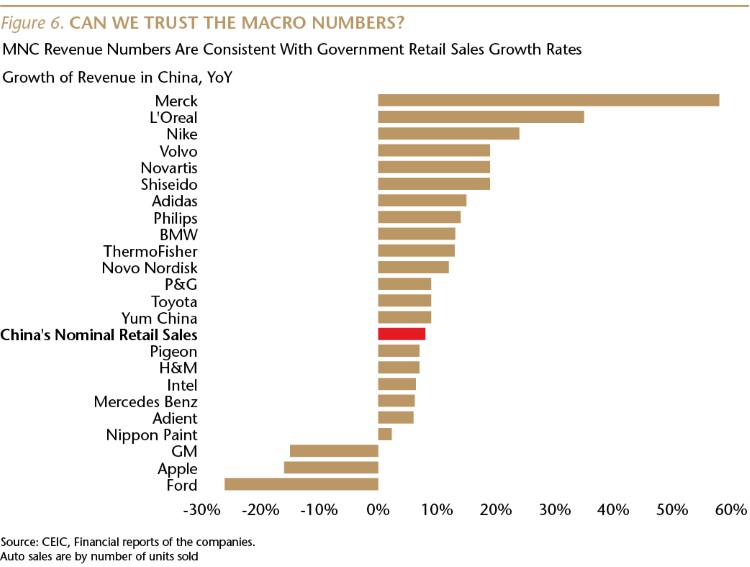
Additionally, the Japanese government reported that spending by Chinese visitors in Japan rose 14.6% YoY last year.
CapEx recovering
Corporate confidence also started to bounce back last month, including by privately owned companies, whose capex spending declined 2.6% YoY, better than the 26.4% fall in January/February. Far from normal, but heading in the right direction in the two months after COVID-19 was brought under control.
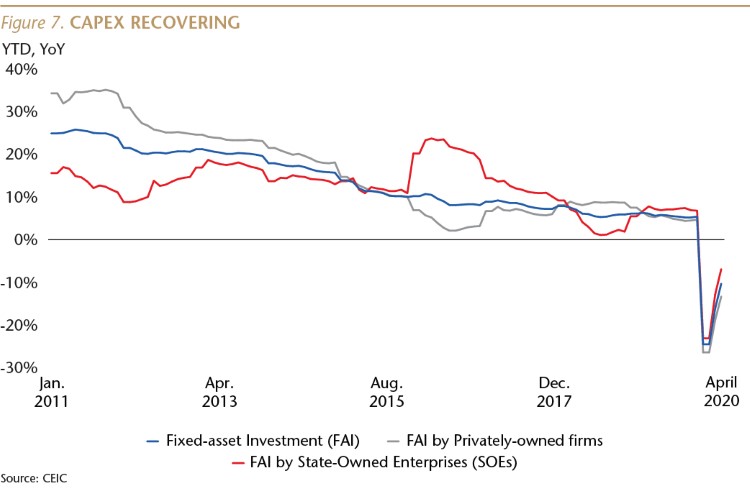
The unemployment risk
In addition to the possibility of a second wave of coronavirus cases, the other risk we are watching closely is unemployment. At the height of the COVID-19 outbreak, it is likely that 70-80 million urban workers (especially migrant workers) either lost their jobs or were unable to return to work. That number is probably now down by half, but that still indicates an unemployment rate of 8-10%.
The absence of social unrest and the rebound in consumer spending suggests that the government's support for workers and businesses has provided a cushion for many who lost their jobs, laying the foundation for an economic recovery. As a result, when the National People's Congress meets later this month, I expect only a modest stimulus designed to broaden the cushion and accelerate the pace of the recovery back towards normal.
Andy Rothman
Investment Strategist
Matthews Asia
As of April 30, 2020, accounts managed by Matthews Asia did not hold positions in L'Oréal S.A., Nike, Inc., Adidas AG, Bayerische Motoren Werke AG (BMW), Apple Inc. and General Motors Company.



